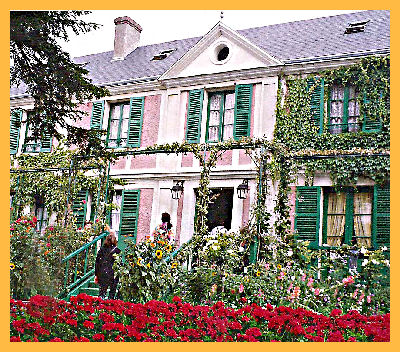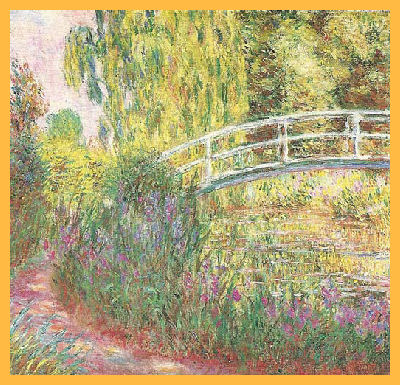 |
|||
 |
|||
 |
|||
 |
|||
 |
|||
 |
|||

by Patricia M. Lee
![]() am
filled with delight, Giverny is a splendid spot for me,” spoke the artist,
Claude Monet, when in 1883 he moved to this charming village in northwest
France. This peaceful region provided a perfect place for him to raise his
sons and pursue his art. He produced many canvases during his career but some
of his most memorable ones came from his life at Giverny.
am
filled with delight, Giverny is a splendid spot for me,” spoke the artist,
Claude Monet, when in 1883 he moved to this charming village in northwest
France. This peaceful region provided a perfect place for him to raise his
sons and pursue his art. He produced many canvases during his career but some
of his most memorable ones came from his life at Giverny.
With a passion for the impressionist artists, my husband, Chuck,
and I, when we traveled, always sought to visit places that displayed art
of that era. So it was that, on a bright sunny day in Paris, we decided to
drive to Giverny to see Monet’s house and gardens.
The two and a half acres is an impressionistic painting of its
own with all the colors gathered together, just like one huge canvas. The
two-story exterior’s crushed pink brick compliments the green doors and
shutters. Fragrant roses climb the trellises and trail across the railings
around the house. The interior consists of kitchen, dining room, bedrooms,
reading and drawing rooms, and the Claude Monet museum studio which, surprisingly,
contains a collection of Japanese engravings. Furniture and antique reproductions
of those times have been restored in most of the rooms. But the reading and
drawing rooms have many authentic pieces used by Monet, such as an 18th century
marquetry writing-desk and an antique chest-of-drawers. Several rooms next
to his bedroom contain paintings of his artist friends including those of
Picasso and Manet. He loved to show friends his art collections.
In 1916, on the site of an old cottage, the Water Lily Studio
and drawing room were completely restored. Vertical light beams down on huge
canvases depicting reproductions of his paintings. It was here that he painted
Decorations des Nympheas, his most famous panels of water lilies.
They are considered the “cradle” of his
artistic legacy.
The gardens provided a kaleidoscope of colorful flowers of every
imaginable shape and size. For example, the red poppies, white hollyhocks,
and red nasturtiums in one part of the gardens are typical of what to expect
in the rest of the area. We strolled the paths, stood for a time at the lily
ponds, and thought of Monet as he roamed the property and became stimulated
with ideas.
We pictured him on his daily morning walk, checking the lighting
and deciding what sites and colors to choose for his paintings that day. He
liked to work on several canvases at the same time, checking the light very
intimately. Monet’s philosophy: “The subject is of secondary importance
to me, what I want to reproduce is what exists between the subject and me.”
Words can hardly express the beauty of our day.
Giverny: www.giverny.org.
Return to: Current articles, Top, Home.

Claude
Monet's Enchanting
Home at Giverny
Monica
Conrady photo

The Japanese Bridge, Water Lily Pond (1900)
Nouvelles Images S.A. photo